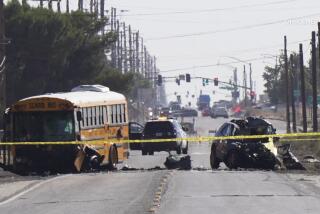Seat Belts on School Buses Not a Sure Cure, Studies Say
- Share via
A mother of a student aboard a school bus that crashed in Redlands on Wednesday morning questioned why the bus wasn’t equipped with seat belts, but some federal studies show the safety devices could have made the situation even worse.
Lap belts on school buses could have caused serious injuries or death, and the more modern lap-and-shoulder harness would have had little, if any, effect on student and driver safety, transportation experts said.
The school bus accident on the San Bernardino Freeway resulted in 25 mild to moderate injuries, including that of the bus driver, whom highway officers praised for her handling of the vehicle carrying 42 students to Clement Middle School in Redlands.
“It does not surprise me that no one died” or suffered serious injury in the crash, said Mike Martin, executive director of the National Assn. for Pupil Transportation, a nonprofit based in Albany, N.Y. “That means the school bus did what it was supposed to do.... A fatality would have surprised me.”
Transporting children in a school bus is extraordinarily safe, Martin said. Nationwide, 24 million students ride in a school bus twice a day, 180 days a year. Of those, Martin said, fewer than seven die annually.
In contrast, 800 students die each year walking, biking or riding in a car to school, he said.
Five states, including California, require installation of a seat belt device on school buses. California is the only one that mandates new school buses leased or bought to have a combination shoulder and lap belt.
Intuitively, seat belts on school buses sound good, said Arlene Soto, whose eighth-grade child was in Wednesday’s bus crash.
After seeing the extensive damage to the bus, Soto said she was relieved that no one was seriously injured.
“But there were some that were hurt, and it bothers me that they are not seat-belted in on the bus,” Soto said. “We were lucky this time.”
Advocates for safety belts on school buses said the devices promote safety and prevent injuries by keeping the kids strapped, thereby reducing driver distractions.
However, the National Transportation Safety Board concluded in 1999, after an 18-month study, that lap-and-shoulder belts provide no added safety and, in severe crashes, could result in unintended harm.
The harness can also injure students if not worn properly -- a likely case, as many adults do so in their cars, transportation experts said.
Engineers design school buses to withstand accidents using a method called passive restraint, Martin said. Seats are closely spaced, with high backs and lots of padding to absorb the impact of a front or rear collision. The roof is also sturdy -- in fact, Martin said, a school bus can be dropped 8 feet and not be crushed.
Still, research shows that a combination lap-and-shoulder belt may be effective in a side collision.
School bus panels do not have extra cushioning, and no restraints exist to keep students from falling into the aisles on impact.
But again, Martin said, there are few fatalities or severe injuries because students sit high above the impact zone.
Most federal studies show that lap belts in school buses are harmful. “The child would be more likely to bend over [on impact], and it could cause injury to the pelvic area,” said Mario Esbri, pupil transportation safety coordinator for the California Highway Patrol.
Esbri added that an existing state law will mandate that most school buses manufactured after July 1, 2005, will be required to install the combination restraint. School buses built before that date do not need to be retrofitted with the system.
More to Read
Sign up for Essential California
The most important California stories and recommendations in your inbox every morning.
You may occasionally receive promotional content from the Los Angeles Times.













